Malcolm Le Grice at USC
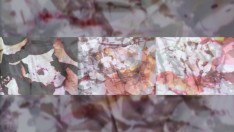
After Monet Water Lilies, by Malcolm Le Grice
Los Angeles Filmforum and USC Cinematheque 108 present Malcolm Le Grice
Thursday February 14, 2019, 7:00 pm
At USC School of Cinematic Arts, The Albert and Dana Broccoli Theatre, SCA 112, George Lucas Building lobby, USC School of Cinematic Arts Complex, 900 W. 34th Street, Los Angeles, CA 90007
Malcolm Le Grice in person!
One of the most compellingly original and radical artist-theorists in the history of the post-war moving image, Le Grice has been innovating at the center and the fringes of time-based media for over fifty years, embracing and exploring the signification of images, multiple projection, and the materiality of media. Le Grice’s body of work functions as an illuminating and rigorous investigation of the fundamental form, essence, and politics of cinema, and this program will span and celebrate the breadth and richness of his singular career. Malcolm Le Grice’s visit made possible by a generous grant from the Mike Kelley Foundation for the Arts.
Designated by the British Film Institute as “probably the most influential modernist filmmaker in British cinema,” Malcolm Le Grice achieved global significance in the 1970s as the doyen of the group of filmmakers centered on the London Filmmakers’ Coop. Often known as “Structural- Materialists,” Le Grice and his cohorts radically extended the material-specific preoccupations of the US “Structural” filmmakers in an aesthetic project of unprecedented formal and theoretical ambition, precision. and clarity. Now a Professor Emeritus of the University of the Arts in London, Malcolm Le Grice is making one of his very rare visits to Los Angeles. USC is honored to welcome him.
He writes: “I was born in 1940 in Plymouth, Devon. I studied Painting in London during the so-called swinging sixties – a period of strong political activity, changes in fashion and life-style and the breaking of artistic boundaries. I started to make film in 1965. Though I continued to paint, film became my main medium together with experiments with computers and other technologies. My earliest 16mm film, Castle 1, was a pre-punk attack on cinema with a live, continually flashing light bulb before the screen. From then I constructed my own printing and developing system – later installing a professional printer at the London Filmmakers Co-op that dominated my ‘materialist’ work until switching to explore multi-projection and digital video. Meanwhile I published a history of experimental cinema, Abstract Film and Beyond (1977), and theoretical essays collected in Experimental Cinema in the Digital Age (2001).”
Tickets: Free but RSVP required, RSVP at https://cinema.usc.edu/events/reservation.cfm?id=43133
This screening is free of charge and open to the public Please bring a valid USC ID or print out of your reservation confirmation, which will automatically be sent to your e-mail account upon successfully making an RSVP through this website. Doors will open at 6:30 P.M. All SCA screenings are OVERBOOKED to ensure seating capacity in the theater, therefore seating is not guaranteed based on RSVPs. The RSVP list will be checked in on a first-come, first-served basis until the theater is full. Once the theater has reached capacity, we will no longer be able to admit guests, regardless of RSVP status.
For more information: https://cinema.usc.edu/events/event.cfm?id=43133, www.lafilmforum.org or 323-377-7238.
Parking: The USC School of Cinematic Arts is located at 900 W. 34th St., Los Angeles, CA 90007. Parking passes may be purchased for $12.00 at the USC Royal Street Entrance, located at the intersection of W. Jefferson Blvd. & Royal Street. We recommend the USC Royal Street Structure, at the far end of 34th Street. Limited street parking is also available along Jefferson Blvd.
Bio
Malcolm Le Grice studied painting at the Slade School of Fine Art but began to make film, video and computer works in the mid 1960s. He has shown in major international venues including at the Museum of Modern Art, New York, the Louvre Museum and Tate Modern. His films and videos are in collections at the Centre Georges Pompidou, the Royal Belgian Film Archive, the National Film Library of Australia, the German Cinematheque Archive and the Archives du Film Experimental d'Avignon. A number of longer films have been broadcast on British TV, including Finnegans Chin (1981), Sketches for a Sensual Philosophy (1986-89) and Chronos Fragmented (1995).
Le Grice has written critical and theoretical work including a history of experimental cinema, Abstract Film and Beyond (London and Cambridge: Studio Vista and MIT, 1977.
For three years in the 1970s he wrote a regular column for the art monthly Studio International and has published numerous other articles on film, video and digital media. Many of these have been collected as an anthology under the title Experimental Cinema in the Digital Age by the British Film Institute (London: 2001). Le Grice is a Professor Emeritus of the University of the Arts London where he is a collaborating director with David Curtis of the British Artists Film and Video Study Collection. Les Presses du réel recently published an extensive book on his works: Le Temps des images, edited by Yann Beauvais (Paris: 2015). https://www.malcolmlegrice.com/
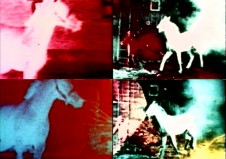
Berlin Horse
Berlin Horse
1970, two-screen version matted side by side on a single 16x9 format, 9 min.
Music by Brian Eno.
Berlin Horse combines two sequences. The first one, showing a horse being exercised, was originally shot in 8mm in the village of Berlin near Hamburg in northern Germany. It was then re-filmed in 16mm from the screen, running the film at different speeds and directions and with the camera at different angles. Later it was re-colored using theatrical lighting gelatins in the film-printer and subject to multiple superimposition, and was finally combined with the second sequence – The Burning Stable, a newsreel of horses being led from a burning barn, made by the Edison manufacturing company in 1896. Both sequences were visually treated and transformed at the London Film Makers Cooperative. The film is a poetic drama where the sequence of image transformations and the 'narrative' are integrated as the content.
“The experience of watching Berlin Horse rests on an appreciation of its almost pure plastic elements: color, movement, rhythm and segments of time. These elements are only ‘almost pure’ because they are activated by the film’s imagery… The lunging of the horse is reflected in the film’s looping structure. The added color dramatizes the burning stable scene, and calls to mind the misregistration and ‘fringing’ endemic in certain experimental color processes during the early part of the 20th century. The motif of the horse in motion also places the film in a lineage that includes Eadweard Muybridge’s proto- cinematic studies of animal locomotion. But for all this, the use of imagery is not directed towards drama, documentary or even reflexivity as such. The aesthetic of the film is a distinct and unique alternative to given modes and conventions of filmmaking.” – Sight and Sound
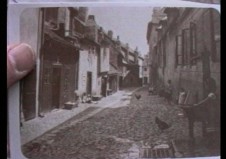
For the Benefit of Mr K
For the Benefit of Mr K
1995, 1 min.
From the earliest point when I started to make film one of the biggest influence on my way of thinking came from Franz Kafka. In particular the titles ‘Castle One’ and ‘Castle Two’ made symbolic reference to Kafka’s book ‘The Castle’. In this book, like ‘The Trial’ the central fictitious but ‘first-person’ existential character was ‘K’ – clearly in part an oblique but intentional reference to Kafka’s own name. The short video sequence used in ‘For the Benefit of Mr. K’, was shot in the little street in Prague showing the small house in which Kafka wrote ‘The Trial’. The title is also a direct reference to the song by the Beatles. The sound track is a short sequence discovered by my son of the Beatles rehearsing this song in the Abbey Road recording studio.
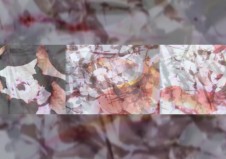
After Monet Water Lilies
After Monet Water Lilies
2008, 3 min
Music/sound Le Grice; Sound re-mix from AMM The Inexhaustible Document
My experience of Monet’s large-scale panoramic paintings of his water lily garden when I was about 14 years old became a crucial artistic memory. There have been a number of versions of the material I shot in about 1984 of water lilies and reeds in a pond. This sketch is the latest version and is part of work on a larger project ‘Treatise’ still in process. The sound was made by AMM for an earlier video work but has been re-mixed for this version.
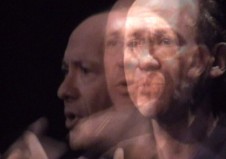
Lecture to an Academy
Lecture to an Academy
2005, 9 mins
Shot in Karlstad Sweden in August 2005 of a lecture by Peter Gidal
When I reviewed the video material it reminded me of a theatre performance which I recalled as “A Lecture to an Academy”, given by Tutte Lemkow at the Arts Lab in Drury lane in 1968. The performance was a translation of Kafka’s "Ein Bericht für eine Akademie". The resulting video work is about the giving of voice - its internal and external experience - the predictive moment before a word and short term memory after it - immediate past and near future mixing with the present/presence.
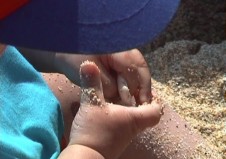
Critical Moments
Critical Moments
2004, 1 mi
‘Critical Moment One’ was an un-planned recording of a one-year old boy exploring shells and sand on a beach. Though the boy was my own grand-son, it was never seen as a ‘home-movie’ – the child’s face is never seen and it was shot over his shoulder - as close to his ‘point-of-view’ as I could get. As a young man and as my own children grew up, I was greatly intrigued by the book ‘The Construction of Reality in the Child’ by Swiss psychologist, Jean Piaget. Piaget made an exceptionally close observation of the changing stages of behavior of his own children which provided me with a conceptual framework for my own observations.
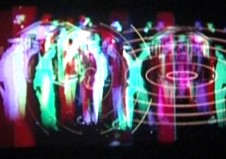
Threshold
Threshold
2007, 18 min
Music/sound Le Grice
Threshold is based on a small number of component sequences. It begins with abstract color fields filling the whole screen then develops through other simple abstract images created by accidental exposure of film stock - edge fogging. The main image of the film is of border guards at a frontier post. The film explores a range of film printing techniques using color filtering, mattes and multiple superimpositions. It also includes a short section of computer generated abstract animation made at the Government Atomic Energy Laboratory in Britain in 1969. The title is intended to imply various forms of threshold or edge when significant transformations occur or are inhibited - the border of a state, the perceptual points when one optical experience transforms to another the point at which an image becomes an abstraction of its shape or movement. The performance version of the film is an improvisation - moving the projectors and superimposing the image as the projection takes place.
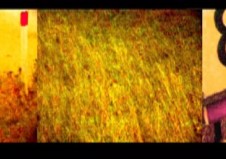
Travelling with Mark
Travelling with Mark
2003, 6 min
Music/sound Le Grice
A digital manipulation exploiting the transcoding ‘mosaic’ of video shot on a train journey from Berlin to southern Germany with Mark Webber. Transformations of selected sequences, - slowed, recolored, compared. New rhythms - slow thoughts inside a train at speed – blurred and fragmented landscape through the window. The sound is produced by frequency manipulation of the train recorded with the video.
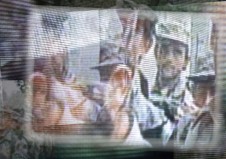
Neither Here Nor There
Neither Here Nor There
2001, 8 min
Osama Bin Laden – Britain and the USA in Iraq as through television reportage – camera only inches from the screen
